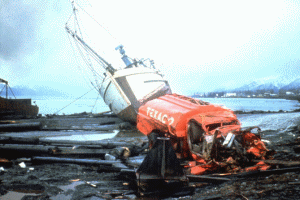| |
A tsunami (soo-NAH-mee) is a series of waves of extremely long wave length and long period generated in a body of
water by an impulsive disturbance that displaces the water. Tsunamis are primarily associated with earthquakes in
oceanic and coastal regions. Landslides, volcanic eruptions, nuclear explosions, and even impacts of objects from outer
space (such as meteorites, asteroids, and comets) can also generate tsunamis.
| |
|

|


